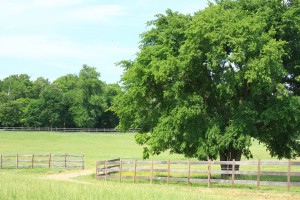Conservation Easements
A conservation easement is a legal agreement between a landowner and a land trust (such as Tar River Land Conservancy) or government agency that permanently limits the uses of the land in order to protect its conservation values. Conservation easements can be crafted to preserve open space, farms, forestland, wildlife habitat, and natural areas by restricting development and other activities that may degrade these features. TRLC works directly with landowners to define mutually agreed upon conservation goals for the property and then incorporates this vision into a written conservation easement agreement. Conservation easements may be placed on all or a portion of a property, depending on the resources being protected and the objectives of the landowner and TRLC.
Conservation easements work best when  landowners plan to retain ownership of the land for the foreseeable future and intend to continue using and enjoying the land as they have in the past. Additionally, conservation easements are a good option if you want to provide protection for your land before selling it or passing it on to heirs.
landowners plan to retain ownership of the land for the foreseeable future and intend to continue using and enjoying the land as they have in the past. Additionally, conservation easements are a good option if you want to provide protection for your land before selling it or passing it on to heirs.
Once signed by the landowner and TRLC, a conservation easement is recorded in the county Registry of Deeds like any other title interest that “runs” with the land. Conservation easements accepted by TRLC are perpetual in duration, meaning that present and future owners of the tract are bound by its terms and conditions.
Financial benefits of granting a permanent conservation easement can also be important. TRLC may purchase a conservation easement from a landowner in certain circumstances, but most conservation easements are donated to TRLC by the landowners. Donations of conservation easements to TRLC often yield significant federal income tax deductions, when certain conditions are met. The amount of the donation is the difference between the land’s value with the easement and its value without the easement, as determined by a licensed real estate appraiser.
 Conservation easements are written to ensure good land stewardship both now and into the future. The conservation easement deed outlines TRLC’s responsibilities for monitoring and enforcing the restrictions placed on the land in perpetuity. At least once a year, TRLC staff and volunteers visit each property protected by a conservation easement and speak with the landowner to ensure that the terms of the easement are being honored and upheld.
Conservation easements are written to ensure good land stewardship both now and into the future. The conservation easement deed outlines TRLC’s responsibilities for monitoring and enforcing the restrictions placed on the land in perpetuity. At least once a year, TRLC staff and volunteers visit each property protected by a conservation easement and speak with the landowner to ensure that the terms of the easement are being honored and upheld.
Landowners contemplating protection of their property should consider not only the land’s conservation value and their desires for the future of the property, but also their family’s financial situation, the steps involved in a project, the upfront costs and potential tax benefits of placing an easement on their land.
Learn about the Steps to Donating a Conservation Easement [PDF]
Learn about the Financial Benefits of Protecting Your Land
Contact TRLC to Discuss Conservation of Your Land
For more information about conservation easements, TRLC recommends these publications:
A Tax Guide to Conservation Easements, by C. Timothy Lindstrom, Attorney-at-Law
Basic Facts and Resources for Landowners, 2008, by the Land Trust Alliance [PDF]



